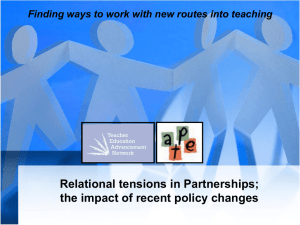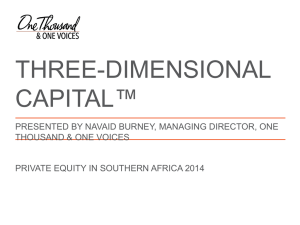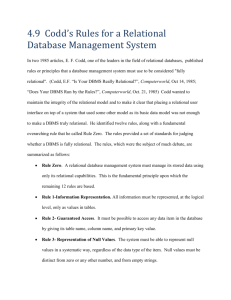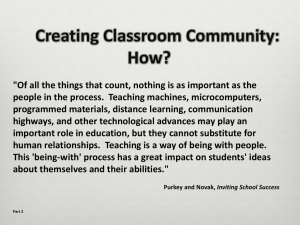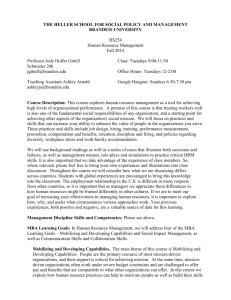Building Relational Coordination At Multiple Levels
advertisement
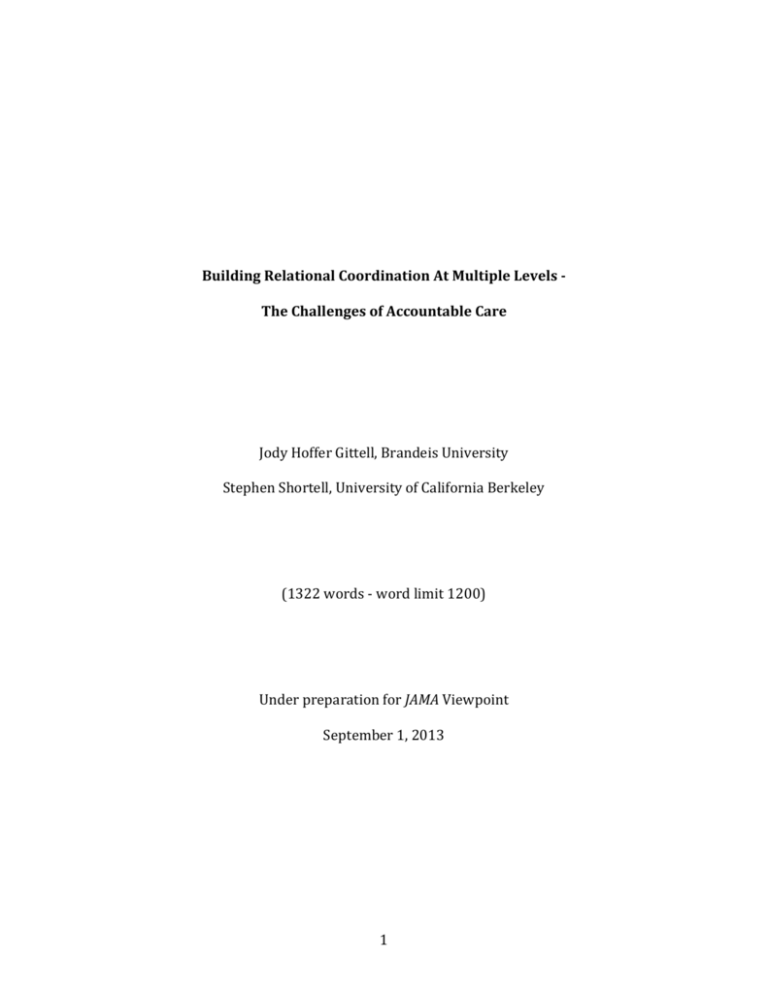
Building Relational Coordination At Multiple Levels The Challenges of Accountable Care Jody Hoffer Gittell, Brandeis University Stephen Shortell, University of California Berkeley (1322 words - word limit 1200) Under preparation for JAMA Viewpoint September 1, 2013 1 Many of us have personal experiences with coordination breakdowns in the health system. Sometimes these breakdowns are frustrating, sometimes they are potentially dangerous, sometimes they are overwhelming, surpassing our ability to cope. Consider a child with obsessive compulsive behaviors who has been assigned a psychologist, a psychiatrist, a neurologist, a family psychiatrist, a family counsellor and an adolescent counsellor in addition to his parents, step-parents, siblings, grandparents, neighbors, teachers and a school guidance counsellor, all involved in some way for better or worse in his healing process. For healing to occur in a timely way, to prevent tragic outcomes while minimizing wasted effort, all care providers would ideally possess both the individual expertise to perform their work and the collective competence to coordinate their work with each other. Yet in this case, the family suffered an inordinate amount of stress fighting the system to achieve a coherent path of care for the child, exacerbating his condition. What went wrong? As often happens, only the family saw the big picture. Each professional was working within his or her own silo, reinforced by his or her professional training, by the reward structures, and by the belief that this is the normal way to work. Even when certain individuals became motivated to achieve a more coherent patient-centered solution due to sympathy for the family and a desire to "do the right thing," they had to invent workarounds to overcome a system that seemed designed to thwart their coordination rather than enable it. This is where relational coordination comes in - coordinating work through relationships of shared goals, shared knowledge and mutual respect.i These positive relationships tend to promote communication that is sufficiently frequent, timely, accurate, 2 focused on problem solving rather than blaming. The result is a virtuous cycle that promotes quality outcomes, efficiently achieved. But when relational coordination is weak, we observe a vicious cycle in which the weakness of shared goals, shared knowlege and/or mutual respect drives insuffiiciently frequent, delayed, inaccurate communication with resort to blaming rather than problem solving. How can this vicious cycle be reversed into a virtuous cycle? Relational coordination is not simply an individual strength or weakness. Rather it operates at multiple levels from individuals, to professional roles, to units, to organizations, and at the system level.ii In the era of accountable care, with the shift away from paying for discrete services to rewards for delivering bundles of care and fostering population health outcomes, we have the opportunity to build a bridge from the treatment of illness to the promotion of wellness.iii In this context it is increasingly clear that the micro, meso and macro levels of healthcare are inter-connected and that achieving relational coordination at only one level is insufficient for achieving sustainable quality and efficiency outcomes. Micro level. At the frontline, individual care providers can and do engage in efforts to "do the right thing" for patients. A longtime cardiac surgeon and physician leader in Kansas observed that frontline care providers are close to the action and can become highly motivated to do the right thing when they see what needs to be done for a particular patient. Taking this a step further, this physician leader has had the experience numerous times of painstakingly building a local context in which relational coordination goes beyond individual heroics to become embedded in the roles of care providers on the unit. Shared goals, shared knowledge and mutual respect across roles -- and with patients and families - become "the way we do things here," supported by coaching and role modeling by leaders 3 who exhibit the art of humble inquiry, and who help to structure opportunities for care providers to develop shared goals, shared knowledge and respect for each others' work. Meso level. Yet this same physician leader has seen numerous times how the local culture "hits the wall" of a non-responsive and sometimes downright hostile organizational environment. He has experienced organizational leaders who see payment systems and resource constraints as antithetical to the promotion of positive relationships and who show outright hostility to these frontline culture building efforts. A unit cannot operate on its own, as patients and staff and resources flow across unit boundaries, and as the unit itself is constrained by the existing reward structure. We know of another system in Montana where the CEO takes seriously the relational infrastructure needed for delivering excellent care safely and efficiently. This CEO is seeking to promote relational coordination across the organization, starting with a unit that enjoys a high level of frontline support as well as a high level of respect from others across the organization. CEO support is demonstrated in many ways, through the personal practices of humble inquiry and role modeling, and through introducing the concepts to leaders throughout the organization, inviting those who are ready to move forward to do so, providing them with the necessary encouragement and support. Macro level. As with most organizations this CEO has inherited some bureaucratic structures that reinforce silos and sacrifice coordination in favor of control. iv Additional changes may be needed in how performance is assessed and rewarded, how conflicts are resolved, how people are hired and trained and how their jobs are designed, changes that will require support from top leadership. 4 And beyond the organization's own boundaries there are additional frontiers to be spanned, as bundled payment reforms are rolled out, along with other payment options that reward the achievement of system wide quality and efficiency of care. Crossing these boundaries requires a whole new level of relational coordination, including the ability to negotiate new contracts and form new relationships. Tools for change. One tool for building relational coordination at the micro, meso and macro levels is the relational coordination metric itself. This seven item measurement tool has evolved in recent years from a pure research instrument into a diagnostic tool to inform organizational change. Its network properties enable it to capure and reflect back to participants the ties through which coordination occurs, among frontline providers, among unit leaders, and across organizations that are involved in the care of particular patients or populations. Increasingly this metric is being used to reflect coordination with patients and families as well, recognizing their central role in the production of health and wellness outcomes.v Conclusion. Recent research has uncovered parallel needs for relational coordination at the micro, meso and macro levels as healthcare organizations seek to implement accountable care.vi This brings us back to the child and the challenge his family faces of integrating his care. The challenges we observe at the micro level need to be addressed - but we simultaneously need to address drivers at the meso level including professional role identities and at the macro level including organizational and crossorganizational rewards. Multi-level concepts like relational coordination that call attention to the relationships as well as the structures that shape those relationships can help us on this journey. 5 i See Gittell, J.H. 2009. High Performance Healthcare: Using the Power of Relationships to Achieve Quality, Efficiency and Resilience. New York: McGraw-Hill. See also Noel, P., Lanham, H., Palmer, R., Leykhum, L. & Parchman, M. (2013). The importance of relational coordination and reciprocal learning for chronic illness care in primary care teams. Health Care Management Review. 38(1): 20-28. Gittell, J.H. & Weiss, L. 2004. Coordination networks within and across organizations: A ii multi-level framework. Journal of Management Studies, 41(1): 127-153. iii Shortell, S. 2013. Bridging the divide between health and health care. JAMA 309(11): 1121-22. iv Gittell, J.H. 2000. Paradox of coordination and control. California Management Review. 42(3): 177-183. OR Gittell, J.H., Seidner, R., Wimbush, J. 2010. A relational model of how high-performance work systems work. Organization Science, 21(2): 490-506. OR Gittell, J.H., Douglass, A. 2012. Relational bureaucracy: Structuring reciprocal relationships into roles. Academy of Management Review, 37(4): 709-754. v Weinberg, D.B., Lusenhop, W., Gittell, J.H., Kautz, C. 2007. Coordination between formal providers and informal caregivers. Health Care Management Review, 32(2): 140-150. vi Rundall, T. and Shortell, S. 2013. Under development. 6

